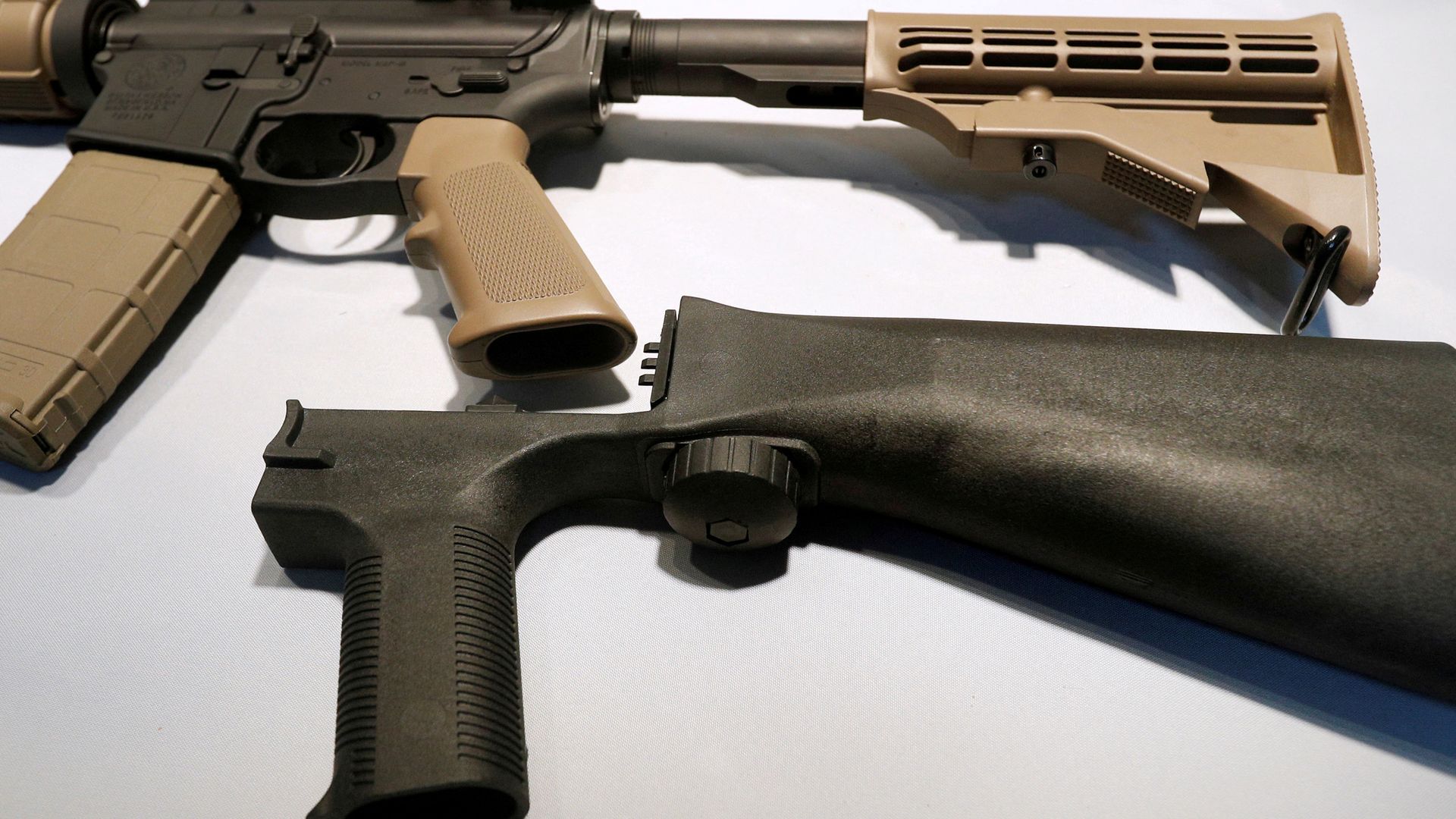
[LAUREN TAYLOR]
NEXT WEEK – THE SUPREME COURT WILL HEAR ARGUMENTS IN A CASE THAT COULD MAKE OWNING BUMP STOCKS – LEGAL AGAIN.
A BUMP STOCK IS A DEVICE THAT ATTACHES TO A SEMI-AUTOMATIC FIREARM AND USES THE RIFLE’S RECOIL TO ALLOW THE SHOOTER TO REPEATEDLY AND QUICKLY DEPRESS TRIGGER.
IN THE EYES OF THE DEPARTMENT OF JUSTICE, THE DEVICE ALLOWS A SHOOTER TO “INITIATE A CONTINUOUS FIRING CYCLE WITH THE SINGLE PULL OF THE TRIGGER” – CONVERTING SEMI AUTOMATIC GUNS INTO MACHINE GUNS.
YOU MIGHT REMEMBER IN OCTOBER 2017 – INVESTIGATORS SAID STEPHEN PADDOCK USED BUMP STOCKS TO CONVERT HIS AR-15S INTO MACHINE GUNS – WHEN HE FIRED MORE THAN A THOUSAND ROUNDS FROM HIS MANDALAY BAY HOTEL ROOM – SHOOTING DOWN ON A CROWD OF MORE THAN 22,000 PEOPLE ATTENDING A COUNTRY MUSIC FESTIVAL.
60 PEOPLE WERE KILLED – HUNDREDS MORE WERE WOUNDED IN THE ASSAULT – WHICH TO THIS DAY – REMAINS THE DEADLIEST MASS SHOOTING IN US HISTORY.
THE FOLLOWING YEAR – PRESIDENT TRUMP IMPOSED A BAN ON BUMP STOCKS IN 2018… AND THE ATF FINALIZED AND PUBLISHED THE RULE IN 2019.. CLARIFYING THAT THE DEFINITION OF A MACHINE GUN – INCLUDES BUMP STOCKS. OPPONENTS OF THE BAN SAY THE DEFINITION OF “MACHINE GUN” IS AMBIGUOUS.
SHORTLY AFTER THE BUMP STOCK BAN WENT INTO PLACE – A TEXAS-BASED LICENSED GUN OWNER AND DEALER NAMED MICHAEL CARGILL – WHO PERSONALLY OWNED BUMP STOCKS AND SURRENDERED THEM TO THE FEDERAL GOVERNMENT – SUED SAYING THE ATF DID NOT HAVE THE AUTHORITY TO PROHIBIT THE USE OF BUMP STOCKS.
THE CASE? GARLAND V. CARGILL –
AND THE 5TH CIRCUIT COURT OF APPEALS RULED – THAT BUMP STOCKS DO NOT FIT THE LEGAL DEFINITION OF MACHINE GUNS.
NOW – THE SUPREME COURT IS TAKING UP THE CASE AND JUSTICES WILL HAVE TO DETERMINE if BUMP STOCKS ARE IN FACT MACHINE GUNS ACCORDING TO FEDERAL LAW.
IT’S PLAUSIBLE JUSTICES COULD USE THE LEGAL TEST OF 1984 CHEVRON DOCTRINE – WHICH ESTABLISHES “THAT COURTS SHOULD DEFER TO AN AGENCY’S REASONABLE INTERPRETATION OF AN AMBIGUOUS STATUTE” – ACCORDING TO SCOTUS BLOG.
MEANING – THE HIGH COURT COULD DEFER TO THE GOVERNMENT TO DEFINE “MACHINE GUN”.
However – the Chevron Rule could be moot by the time the high court rule on this case – since justices heard two cases involving the chevron doctrine last month – and it’s possible justices could overrule the chevron doctrine.
RIGHT NOW – UNDER 26 USC 5845 –
“MACHINE GUN” MEANS ANY WEAPON WHICH SHOOTS, IS DESIGNED TO SHOOT, OR CAN BE READILY RESTORED TO SHOOT, AUTOMATICALLY ONE SHOT, WITHOUT MANUAL RELOADING, BY A SINGLE FUNCTION OF THE TRIGGER… AND THAT THE TERM ALSO INCLUDES ANY “COMBINATION OF PARTS DESIGNED AND INTENDED, FOR USE IN CONVERTING A WEAPON INTO A MACHINE GUN.”
JUSTICES WILL HEAR ARGUMENTS FEBRUARY 28.







